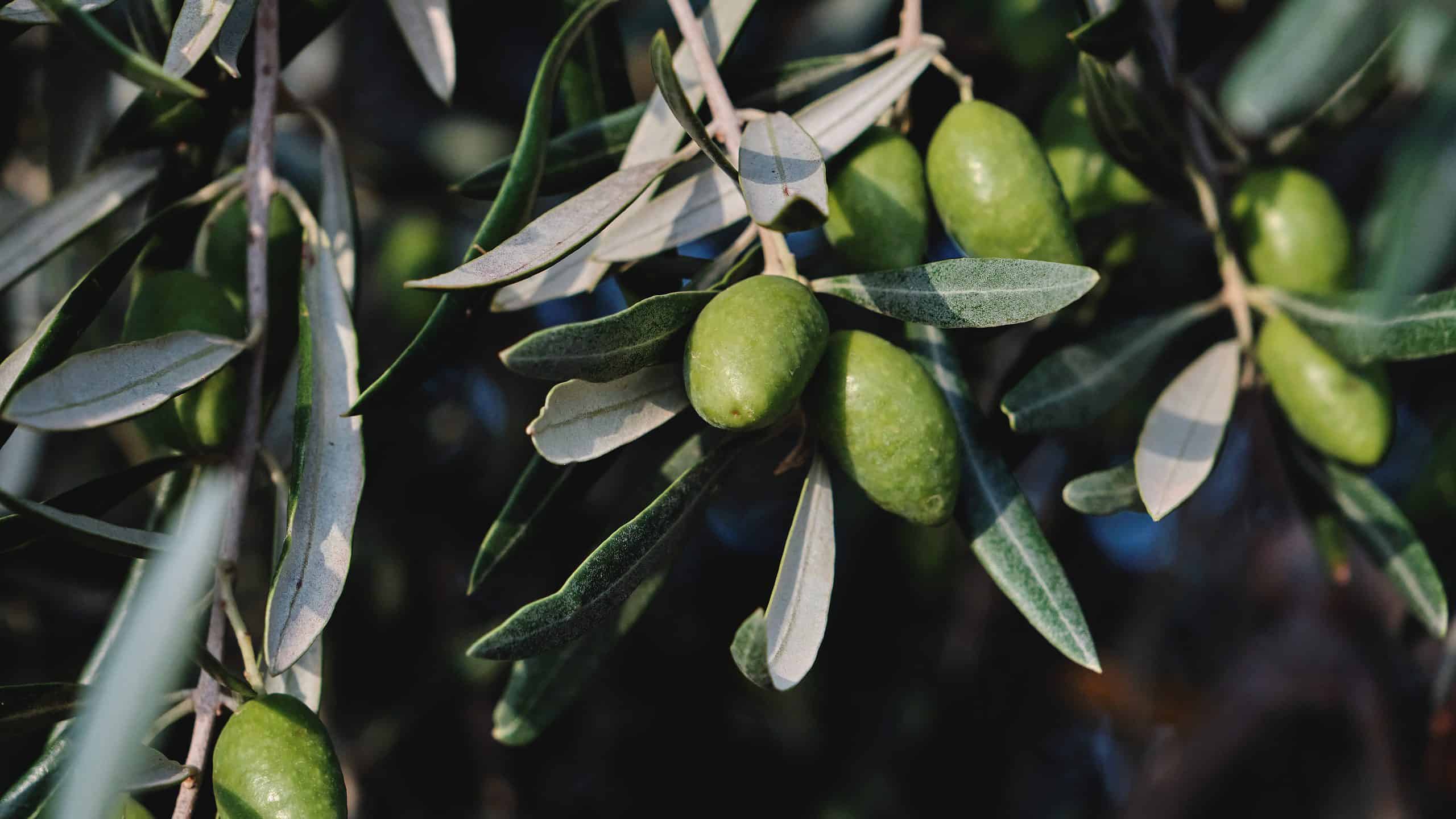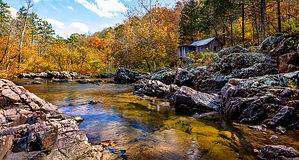Trees have a deep significance in many religious texts, including the Christian Bible. They represent abstract beliefs, themes, and overarching tones for how to live your life. Some trees demonstrate physical manifestations of parable meanings while others show up often in Biblical texts.
Discover which trees the Bible mentions more than once and the meanings or significance of those trees. Also, learn how to grow these trees in your yard.
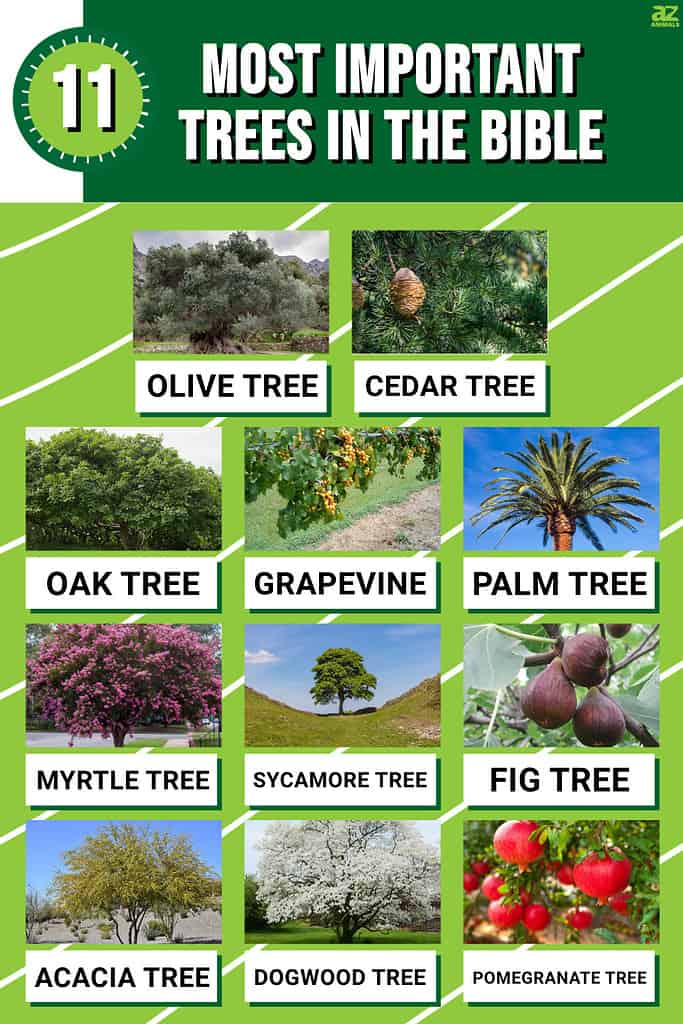
List of the 11 Most Important Trees
The Bible mentions dozens of plants and trees, but the following 11 carry a larger meaning in both history and theology.
Olive Tree

The Vouves Tree is located on Crete in Greece and it’s over four thousand years old.
©Georgios Tsichlis /Shutterstock.com
Olive trees, native to the Mediterranean coast and Europe as a whole, have been farmed by humans for over 6,000 years. Based on archeological evidence, ancient humans used olive trees for their fruits, oils, and wood. The olive tree is a slow-growing evergreen tree that remains surprisingly resilient and long-lasting. Olives meant for consumption are harvested in the fall while those used for oil are left to fully grow and picked in the winter.
Cedar Tree
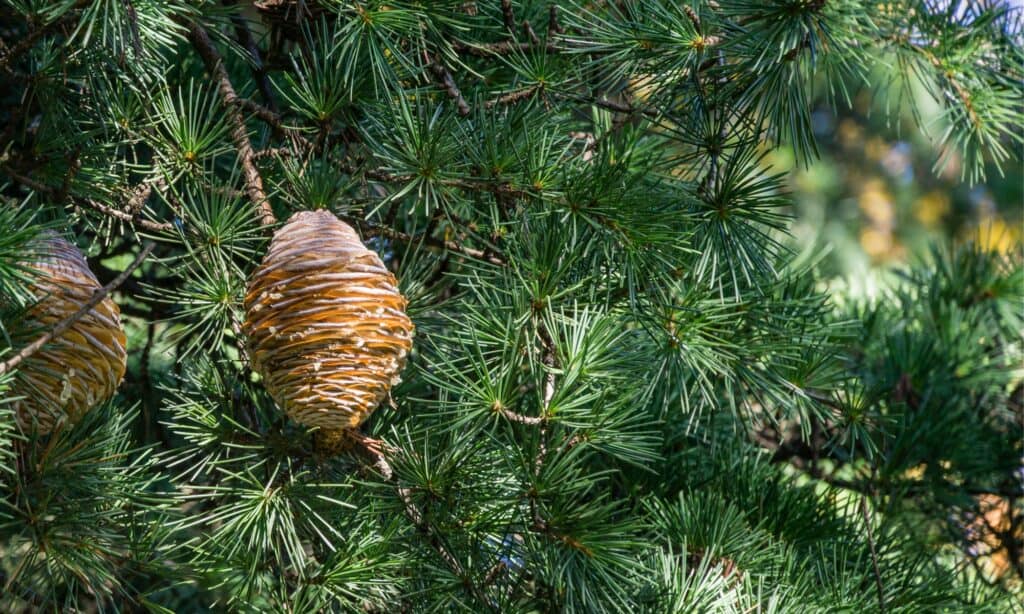
Most cedar trees produce cones and fruits.
©iStock.com/Marina Denisenko
“Cedar” encompasses a multitude of different evergreens that belong to the pine family. However, you can identify most cedars by their fern-like needles, the white wax covering their needles, and the uniquely-colored dark gray or reddish-brown trunks. Often used in landscaping and cut down to make durable, attractive furniture, cedar trees remain popular in modern times.
Oak Tree
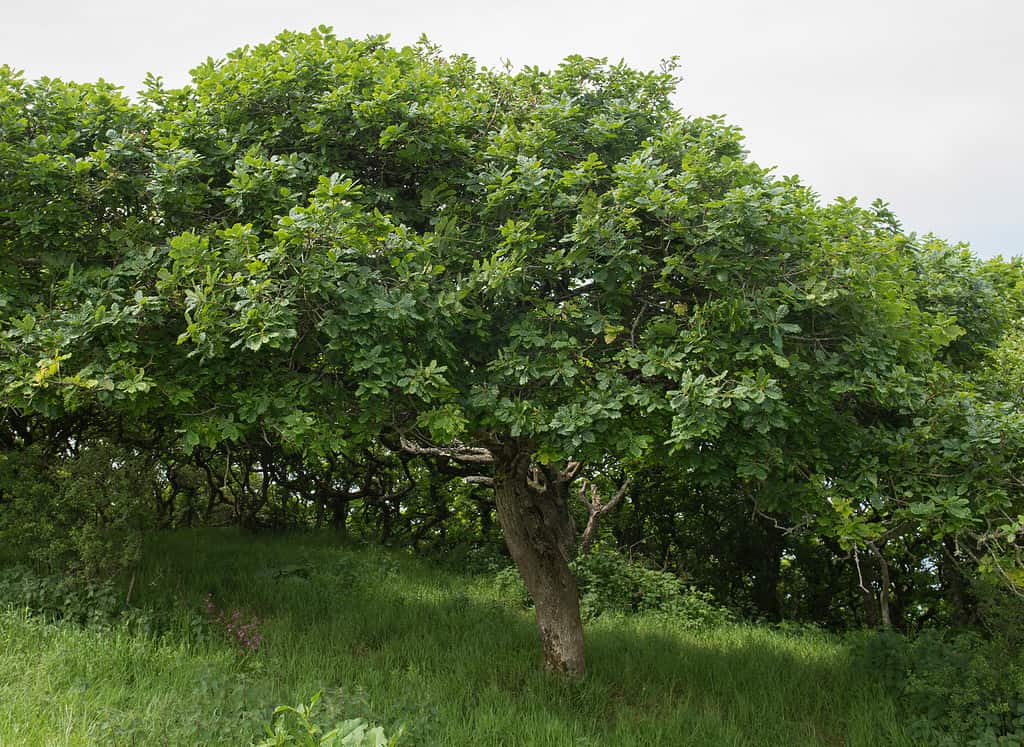
These large deciduous trees reach up to 131 feet tall and have long lives.
©Peter Turner Photography/Shutterstock.com
With over 500 species of oak trees, many different types of oaks may be mentioned in the Bible. Oak trees have an incredibly long lifespan and produce acorns up to 700 years of life. Not all oaks are evergreen, but some like Live Oaks are. Additionally, the tree and acorns produce tannic acid to self-preserve from fungi and various insects.
Grapevine
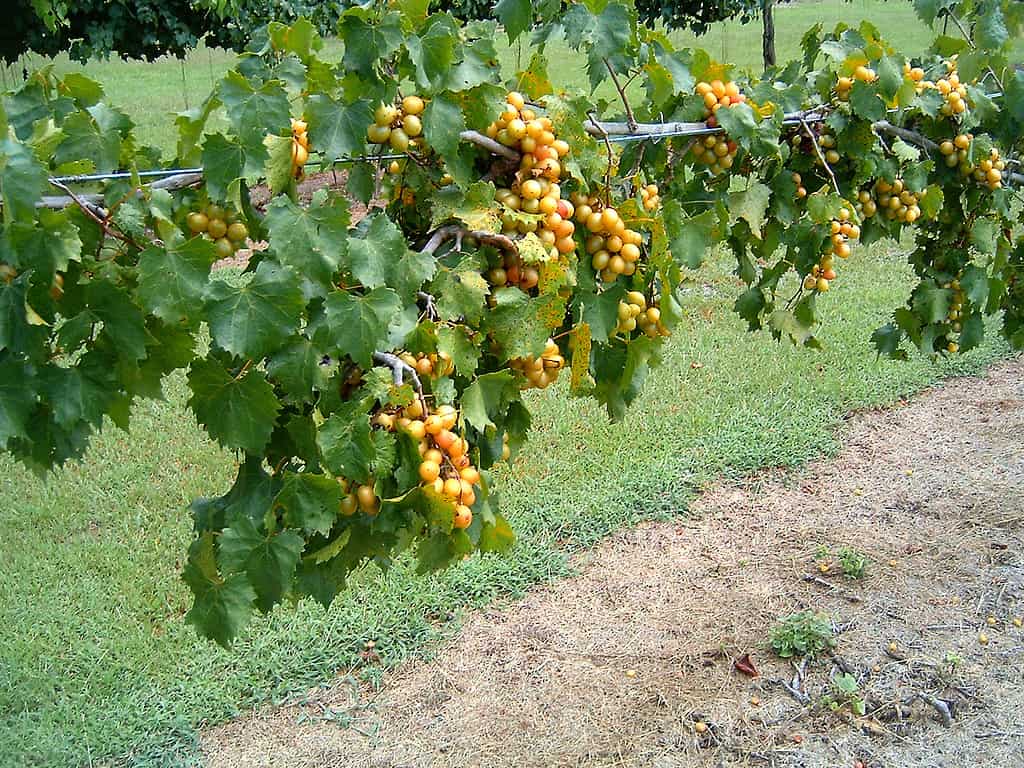
Grapevines often climb on trellises.
©iStock.com/Dean-C
While not technically a tree, grapevines look like mini trees with their sturdy trunks and leaf-covered arms. Grapevine naturally climbs and can grow on top of trees, trellises, stakes, and more. Grapevines have large leaves and fruit clusters of green, purple, or black grapes.
Palm Tree
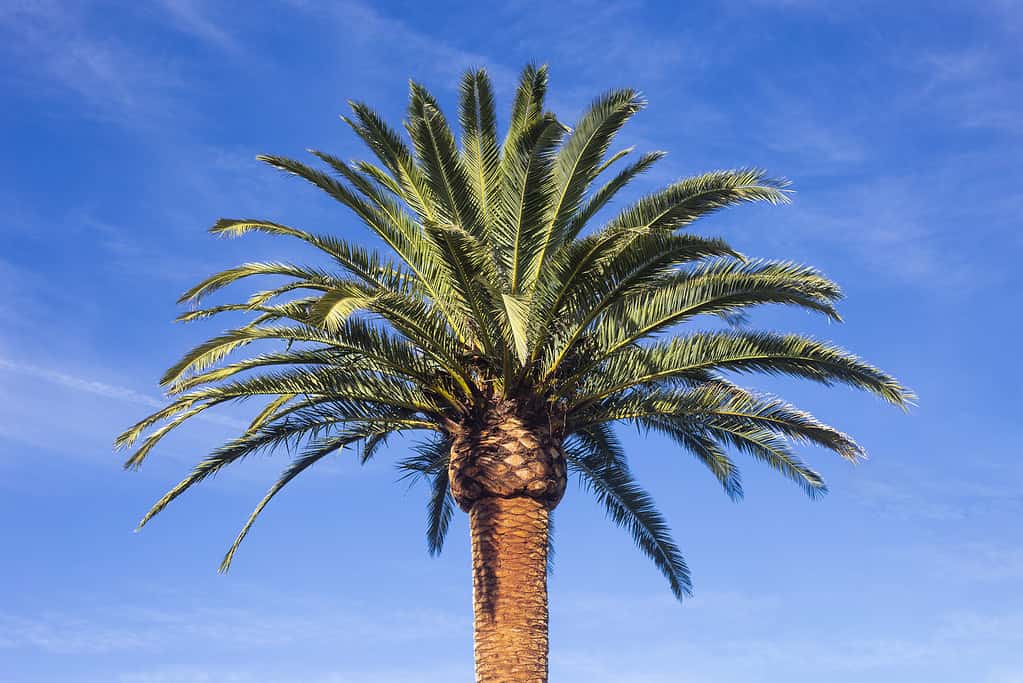
Palm trees carry meanings of victory, righteousness, and abundance.
©iStock.com/MANUEL FIL ORDIERES GARCIA
Graceful and towering, the palm tree is a universal symbol of victory, triumph, and resilience. It carries cultural and historical significance in more than one culture, representing peace, abundance, and righteousness in various civilizations, and is associated with paradise and tropical landscapes.
Myrtle Tree

Myrtle tree flowers often represent romance.
©Noel V. Baebler/Shutterstock.com
With fragrant leaves and delicate flowers, the Myrtle tree symbolizes love, beauty, and immortality. Its cultural significance culminates in the illustration of romance, purity, and divine favor, as the myrtle tree is often used in weddings and religious ceremonies.
Sycamore Tree

Many cultures and religions feature sycamore trees in their texts, mythologies, and lore.
©iStock.com/dapec
Recognizable by its distinctive mottled bark, the sycamore tree represents strength, protection, and rebirth. It carries cultural and historical significance in more than just Christianity. In fact, it features prominently in ancient Egyptian mythology, symbolizing life, fertility, and the afterlife.
Fig Tree
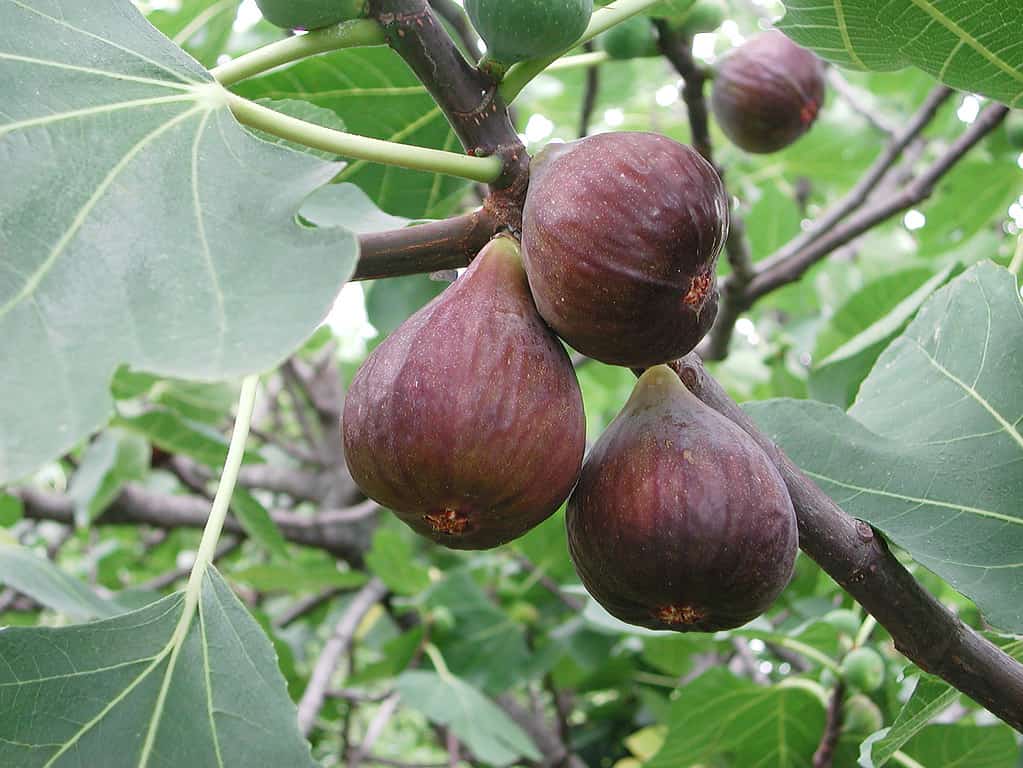
Fig trees represent bountifulness in the Bible.
©simona pavan/Shutterstock.com
The fig tree symbolizes fertility, abundance, and enlightenment with its broad, lobed leaves and sweet fruits. It holds cultural and historical significance and is associated with knowledge, spiritual awakening, and the intertwining of the material and spiritual worlds.
Acacia Tree
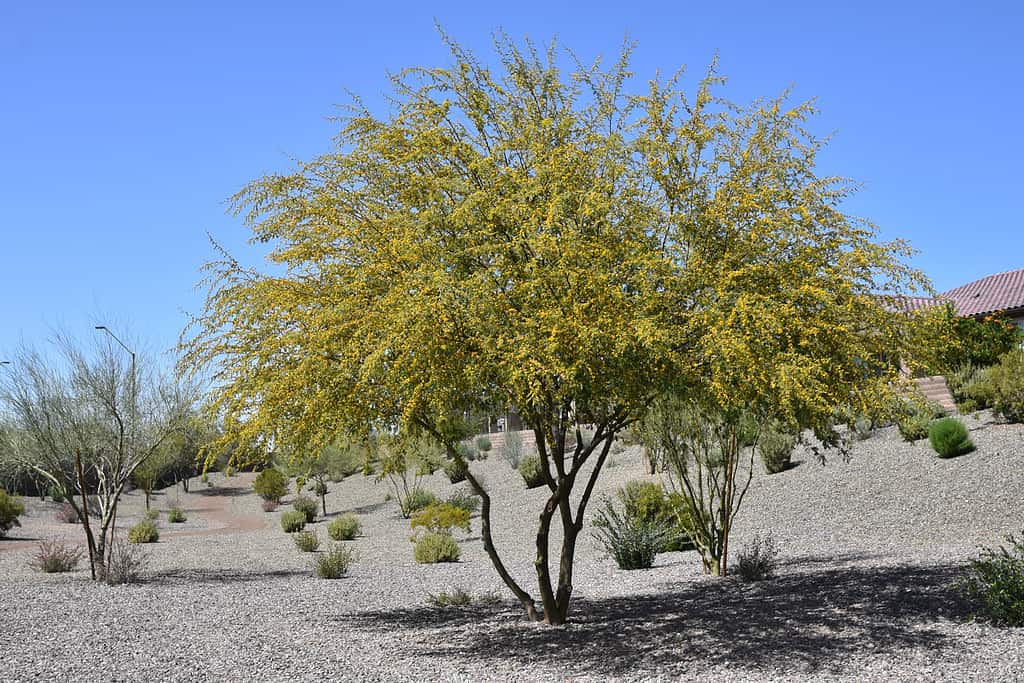
Sweet acacia trees can bloom in hotter, more arid climates like in the Middle East.
©Thomas Trompeter/Shutterstock.com
Known for its feathery leaves and fragrant flowers, the acacia tree symbolizes purity, resilience, and spiritual awakening. It features in ancient Egyptian mythology, representing rebirth, protection, and the gateway to the divine.
Dogwood Tree

Dogwoods have tough wood and hold special significance in Christianity.
©Virunja/Shutterstock.com
A dogwood tree is a type of flowering ornamental tree with very hard wood. Its flowers bloom in colors like white, pink, purple, and yellow. Interestingly, the grain of the wood is nearly imperceptible. The symbolism of the dogwood tree lies in its role in Jesus’ crucifixion and is commonly regarded as an Easter tree.
Pomegranate Tree
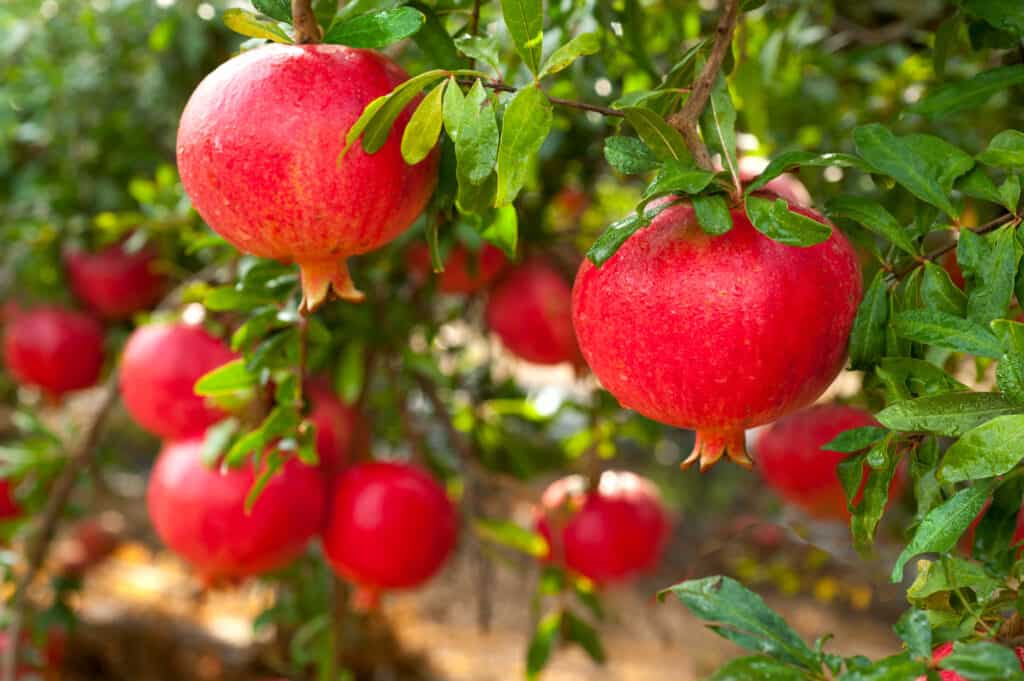
A pomegranate tree often symbolizes prosperity in the Bible.
©grafnata/Shutterstock.com
Adorned with vibrant red fruits and glossy leaves, the pomegranate tree symbolizes fertility, abundance, and prosperity. It represents life, regeneration, and love — and is associated with various mythologies, religious traditions, and cultural practices.
Symbolism and Meaning of Trees

The Bible mentions these 11 trees for specific reasons.
©iStock.com/freedom007
Each tree mentioned in the Bible gets called out by name for a reason. Discover the religious significance of these 11 Biblical trees, the messages or themes they communicate, and how their symbolism continues to influence the world.
Olive Tree
Olive trees curry favor throughout the Bible and remain a long-standing symbol of peace, harmony, prosperity, and covenants between two parties. In the Old Testament, a dove brings Noah an olive branch after the Great Flood to signify the earth was ready to grow new life again. As a plant, the olive tree takes patience to grow and thrive — an allegory for our relationship with God. Don’t forget, even Jesus prayed under a garden of olive trees to talk to God the night before he was crucified.
Cedar Tree
Cedarwood itself possesses a pleasant aroma and remains pretty resistant to bugs or decay. The Bible specifically calls out the “Cedars of Lebanon” as stately, slow-growing, and steadfast trees to which good Christians should compare themselves. The Cedars of Lebanon, however, are a sobering reminder to believers that every good and pure thing comes from God — and if taken for granted, judgment will come.
Oak Tree
Have you ever been called an “oak of righteousness?” Throughout the Old and New Testaments, oak trees symbolize stability and strength, like when describing King Solomon’s rule or the righteousness of Job. Another belief persists as well: that the oak tree symbolizes when God is present in a situation. Overall, oaks are sturdy, reliable trees that weather trials well, just as Christians should aim to do in the face of adversity and persecution.
Grapevine
The grapevine, or just a vine, carried the significance of Israel’s relationship with God. Not only Israel, but all believers in God. Jesus makes the metaphor in the New Testament that he himself is the vine, and the only way to Heaven is through belief in him, specifically saying, “I am the true grapevine, and my Father is the gardener. He cuts off every branch of mine that doesn’t produce fruit, and he prunes the branches that do bear fruit so they will produce even more.”
Palm Tree
Palms and palm trees are closely associated with Jesus’ exuberant entrance into Jerusalem. They also carry another significance: the fronds used in Christian Palm Sunday celebrations are burned to create the ash for Ash Wednesday.
In addition, palms are used to signify “victory over the flesh” in some Bible stories.
Myrtle Tree
Myrtle trees have one simple symbol in the Bible: prosperity or God’s promised blessings. They stand for any synonym of fertility — whether it’s a productive harvest, an air of positivity and hope through hardship, or a feast after a long fasting period or drought.
Sycamore Tree
In the New Testament, a man named Zacchaeus climbed a sycamore tree to see Jesus preach amid a large crowd of people. At the time, it was considered embarrassing for a grown man to climb a tree — but Zacchaeus abandoned his pride in the hopes of seeing Jesus. Many believers consider this symbolism to be a place in our lives where we have a clear picture of God and his teachings.
Fig Tree
Fig trees have deep meanings in the Bible and range from symbolizing Israel itself to security or inner peace. Again and again, figs find mention in the Old and New Testaments as symbols of safety, bountiful families, and decadence. Furthermore, a fig tree is one of the only types of trees explicitly mentioned in the Garden of Eden.
Acacia Tree
Did you know that acacia wood is one of the only hardwood trees growing in the Middle East and Israel? As a strong wood built for construction, it’s no wonder the Bible mentions acacia wood and trees in the same context as the Ark of the Covenant and Tabernacles. Acacia wood was used to build the holy Tabernacle of Moses and was so strong, it was allegedly in use for 400 years after its creation.
Dogwood Tree
Scholars and Biblical students believe the cross on which Jesus was crucified was built from dogwood. As such, it is said that God both blessed and cursed the dogwood tree. The “Legend of the Dogwood Tree” persists both in and out of Christian theology, mystifying other religious followers, gardeners, and more.
Pomegranate Tree
Rich in seeds, color, and flavor, the pomegranate tree specifically illustrates themes of prosperity and wealth in the Old Testament books Numbers and Deuteronomy. Tangentially related to Christian theology, some Jewish Traditions think that pomegranates were chosen to color the robes of priests and as temple decorations because they have 613 seeds — just as the Torah has 613 laws to follow.
Trees and Christian Spirituality
It’s clear that Biblical trees hold significant meaning, symbolism, and beauty. Trees in Christian spirituality represent more than growth and specific parables; they act as a reminder to all faithful Christians of God’s creation, love, and kindness.
In Christian theology, God is the omnipotent creator of all things — trees included. Not only does He provide trees for humans to sustain themselves with the fruits and seeds of them; but believers feel trees also exist because God wants to create beauty for his children to appreciate.
Throughout the Bible, trees symbolize different themes and meanings, as discussed above. They also demonstrate some abstract principles, like drawing a parallel between humans or illustrating the prospect of eternal life.
When describing trees, the language used is comparative to that of the descriptions for the creation of humans. For example, both “spring up from the ground.” Furthermore, the language used around both items’ characteristics or interactions with other things in the world remains similar, including words like:
- Uprooted.
- Seeds.
- Fertile.
How can you enhance your relationship with God through understanding trees? Understanding how God wants His children to perceive trees can grow your faith and shape the way you act in God’s image. Maybe you’ll have a deeper appreciation or respect for nature after understanding that God created trees for us to marvel at — or perhaps the parallels between your life and a Biblical tree’s longevity will reshape how you want to use your time on earth.
How to Grow and Care for Biblical Trees

You can grow cedars, among the other Biblical trees, in your backyard almost anywhere in the United States.
©Alexander Denisenko/Shutterstock.com
Looking to grow one of the aforementioned Biblical trees to bring more symbolism and spirituality to your life? Luckily, many of the trees mentioned in the Bible are adaptable and resilient plants, so they can — and will — take root almost anywhere with a temperate climate and the right gardening.
Here’s a handy guide to growing Biblical trees in your backyard.
Olive Tree
Flourishing in well-drained soil, the olive tree finds solace in a balanced mix of loam and sand. During the initial growth phase, ample watering is essential, yet once mature, it displays resilience to drought conditions. Pest management necessitates vigilant monitoring of olive fruit flies and adopting organic insecticides or pheromone traps.
Cedar Tree
Adaptable to diverse soil types, cedar trees exhibit a preference for well-drained and slightly acidic soil. While periodic watering in dry spells is crucial, it’s crucial to avoid excessive moisture. Resilient against pests, cedar trees still warrant occasional checks for caterpillars or borers to maintain their health and vitality.
Oak Tree
Oak trees showcase adaptability, accommodating various soil types, yet they thrive best in well-drained loamy soil. Adequate watering during dry spells ensures their sustained growth. Vigilant pest management entails monitoring diseases like oak wilt. Also, addressing insect infestations such as oak gall wasps protect their flourishing existence.
Grapevine
Rooted in well-drained soil with a pH range of 5.5 to seven, grapevines bask in regular watering, especially during fruit development. Prudent pruning and trellising techniques fortify their defenses against pests like grape leafhoppers and fungal diseases such as powdery mildew.
Palm Tree
Thriving in a variety of soil types, palm trees hold a particular affinity for well-drained soil, be it sandy or loamy. Moderate water requirements demand regular hydration. Diligent pest management necessitates monitoring for palm aphids or spider mites while addressing nutritional deficiencies to ensure their presence endures.
Myrtle Tree
Flourishing in fertile, well-drained soil with a broad pH tolerance, myrtle trees eagerly receive moisture during dry spells and embrace the benefits of mulching to preserve vital hydration. Pest management revolves around meticulous observation of aphids, scale insects, or fungal diseases, adopting tailored treatments for their unwavering protection.
Sycamore Tree
Moist, well-drained soil satisfies the sycamore tree’s growth cravings, adapting amiably to varying soil types. While they possess moderate water requirements, regular watering, especially during extended dry periods, sustains their vitality. Astute pest management entails monitoring diseases like anthracnose and addressing infestations such as sycamore lace bugs.
Fig Tree
With a preference for well-drained soil boasting a pH range of 6.0 to 6.5, fig trees savor moderate water needs, emphasizing deep yet infrequent watering practices. Vigilant pest management involves scrutiny for fig beetles or nematodes, coupling preventive measures like pruning and appropriate spacing to uphold their fruitful presence.
Acacia Tree
Adapting graciously to diverse soil types, including sandy or clayey compositions, acacia trees unveil their magnificence. Exhibiting low to moderate water needs, once established, they showcase remarkable drought tolerance. Astute pest management entails monitoring pests like borers or aphids, complemented by vigilant disease control to safeguard their flourishing existence.
Dogwood Tree
Dogwood trees prefer well-drained soil rich in organic matter, with a slightly acidic to neutral pH. Adequate watering during dry periods is crucial, ensuring the soil remains moist but not waterlogged. Pest management for dogwood trees involves monitoring for issues such as powdery mildew, leaf spot diseases, and dogwood borers, and implementing appropriate treatments.
Pomegranate Tree
Embracing adaptability, pomegranate trees thrive in well-drained soil, accommodating various types with ease. Regular watering, particularly during flowering and fruiting stages, nurtures their growth and fosters a bountiful harvest. Attentive pest management entails vigilant monitoring of pests like fruit flies or aphids, employing organic insecticides or traps when necessary, and ensuring the pomegranate tree’s continued prosperity.
Biblical Trees Carry Significant Meanings
Like colors, flowers, spices, and numbers, trees mentioned in the Bible carry meanings both in Christian theology and other cultures. So, when choosing to plant a Biblical tree in your backyard or garden, enjoy the fruits, flowers, and special significance it brings to your life.
Summary of 11 Most Trees in the Bible
| Number | Tree |
|---|---|
| 1 | Olive Tree |
| 2 | Cedar Tree |
| 3 | Oak Tree |
| 4 | Grapevine |
| 5 | Palm Tree |
| 6 | Myrtle Tree |
| 7 | Sycamore Tree |
| 8 | Fig Tree |
| 9 | Acacia Tree |
| 10 | Dogwood Tree |
| 11 | Pomegranate Tree |
Thank you for reading! Have some feedback for us? Contact the AZ Animals editorial team.

